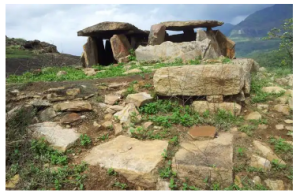Context:
A large number of megalithic hat stones were found during a recent archaeological salvage excavation conducted by the Kerala Archaeology Department at Nagaparamba in Kuttippuram village, near Tirunavaya.
About Hat Stones:
- Hat stones, popularly called Thoppikkallu in Malayalam, are hemispherical laterite stones used as lid on burial urns during the megalithic period.
What is Salvage excavation?
- Salvage excavation also known as rescue archaeology or emergency archaeology, refers to a type of archaeological excavation that is conducted in response to a situation where archaeological remains are threatened by construction, development, or other activities
Megaliths
- Megaliths were constructed either as burial sites or commemorative (non-sepulchral) memorials.
Commemorative non-sepulchral memorials:
- Commemorative non-sepulchral memorials are monuments, structures, or installations that are created to honor and remember individuals, events, or significant aspects of history without being associated with burial or interment.
- These memorials serve as a tangible and lasting tribute to commemorate the past and convey its significance to present and future generations
|
- Origin: As megalithic societies were preliterate, the racial or ethnic origins of the megalithic people are thus difficult to pin down.
- Significance: Megaliths were not built for commoners. They signify the emergence of a ruling class or elite who presided over a surplus economy.
- Time – Period: In India, archaeologists trace the majority of the megaliths to the Iron Age (1500 BC to 500 BC), though some sites precede the Iron Age, extending up to 2000 BC.
 Geographical Spread: Megaliths are spread across the Indian subcontinent, though the bulk of them are found in peninsular India, concentrated in the states of Maharashtra (mainly in Vidarbha), Karnataka, Tamil Nadu, Kerala, Andhra Pradesh and Telangana.
Geographical Spread: Megaliths are spread across the Indian subcontinent, though the bulk of them are found in peninsular India, concentrated in the states of Maharashtra (mainly in Vidarbha), Karnataka, Tamil Nadu, Kerala, Andhra Pradesh and Telangana.-
- Even today, a living megalithic culture endures among some tribes such as the Gonds of central India and the Khasis of Meghalaya.
- Different Types of Megalithic Structure include: Stone Circles, Dolmen, Cist, Monolith and Capstone style.
Thirunavaya
- The land of ancient Mamankam, Tirunavaya is south of Tirur.
- Situated on the banks of Bharathapuzha river; it is a place of historical importance.
- In olden days, Mamankam a grand assembly of rulers was held once in 12 years here.
|
News Source: The Hindu
![]() 21 Aug 2023
21 Aug 2023
 Geographical Spread: Megaliths are spread across the Indian subcontinent, though the bulk of them are found in peninsular India, concentrated in the states of Maharashtra (mainly in Vidarbha), Karnataka, Tamil Nadu, Kerala, Andhra Pradesh and Telangana.
Geographical Spread: Megaliths are spread across the Indian subcontinent, though the bulk of them are found in peninsular India, concentrated in the states of Maharashtra (mainly in Vidarbha), Karnataka, Tamil Nadu, Kerala, Andhra Pradesh and Telangana.